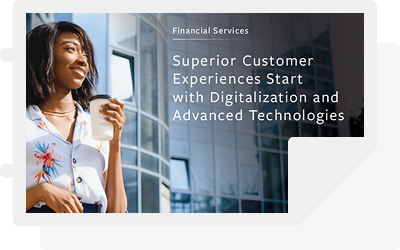New Year’s resolutions have never really been my thing. I prefer to take stock of the good, channel that into what’s next, and keep on running. Pair that with my optimistic nature and, well, I tend to see opportunities everywhere – not the least of which come in the form of digital transformation.
We’re just a few days into the blank canvas that is 2021. Wherever your financial services organization stands on the transformation front, it’s time to build on last year’s momentum and get closer to that finish line than ever before.
BMC research we carried out just before the pandemic began showed nearly half of companies surveyed see no specific end date for automation adoption. They view it as a continual improvement project, and that’s not necessarily a bad thing. Digital transformation itself isn’t a ‘one-and-done’ project. It’s bigger, taking shape as a fundamental shift that reimagines the very way organizations work.
Diving deeper, though, our survey revealed a sliding scale of progress among the other half of respondents. Twenty-three percent said they’re just getting started with automation; 13% are about one-third of the way along. A mere 9% say they’ve crossed the halfway point.
That worries me, not because progress must come quick. Rather, because lagging progress can mean missed opportunities for financial services organizations – especially after the year we’ve just wrapped.
Almost half of financial services employees reported increased productivity during the pandemic. Many of us link that back to the fact that financial services were already more digital when compared to other industries. From providing customer service with minimal disruption to enabling your people to access self-serve IT support: the more digital you are, the better chances you have of adapting quickly in any given scenario. That will continue to be a differentiator for this sector in the year – and years – ahead.
The question isn’t should you resolve to further digital transformation this year; it’s how. What can you prioritize to start closing those transformation gaps once and for all?
- Remove the manual processes from your operations by turning work into workloads. We’ve been talking about workload automation for years. As the physical space between colleagues and customers widened to a cavernous gap in 2020, those early calls for digital investment became more and more relevant. Using automation to complete tasks releases tremendous potential from within your own teams. Cutting back on manual processes can boost performance, offset tasks tied to focus areas like data processing or app development, dial down human error, and so much more. Automating workflows also helps you spot signs of trouble more quickly. That counts for a lot as cyber risk has continued to spike over the course of the pandemic.
- Provide governance platforms and services to offer guardrails for innovation, but don’t inhibit technology. Good governance doesn’t impede technology and transformation. It cultivates a rich environment where innovation can thrive. When you’ve got the right IT governance in place, you can align corporate strategy with information technology in ways that help the entire business work better together. At BMC, we’ve always defined strong governance as coming down to leadership, clarity around organization and decision rights, and scalable processes and enabling technologies. Putting the right people in place to oversee governance, connecting the organization, and communicating clearly are equally important as you become a truly autonomous digital enterprise. Doing so enables you to measure results, mitigate risks, and make data-driven decisions along the way.
- Refresh your tech stacks to modern digital platforms. At a minimum, wrap your legacy workloads with microservices. Whether we’re talking about the front end of your tech stacks (where customers interact) or the back end (where your people deliver), updating yours to make the most of the latest technology is always a good thing. Doing it in ways that tie back into your legacy workloads and microservices is even better. The microservice architecture you choose enables you to deliver large and complex applications quickly, frequently and reliably. That plays a big part in how your organization evolves its tech stack to take advantage of new opportunities in the market with resilient services. Identify the areas where improvement is poised to deliver the greatest uptick, and invest strategically now.
Eating healthier; exercising more… It’s early days yet for the plethora of January goals we tend to set. We won’t achieve any of them without a strong plan. Same goes for digital transformation. If this perennial favourite has been lingering on your ‘to complete’ list, now’s the time. Here’s to a productive, progressive and digital new year for us all.
Financial Services Superior Customer Experiences Start with Digitalization and Advanced Technologies
These postings are my own and do not necessarily represent BMC's position, strategies, or opinion.
See an error or have a suggestion? Please let us know by emailing blogs@bmc.com.







